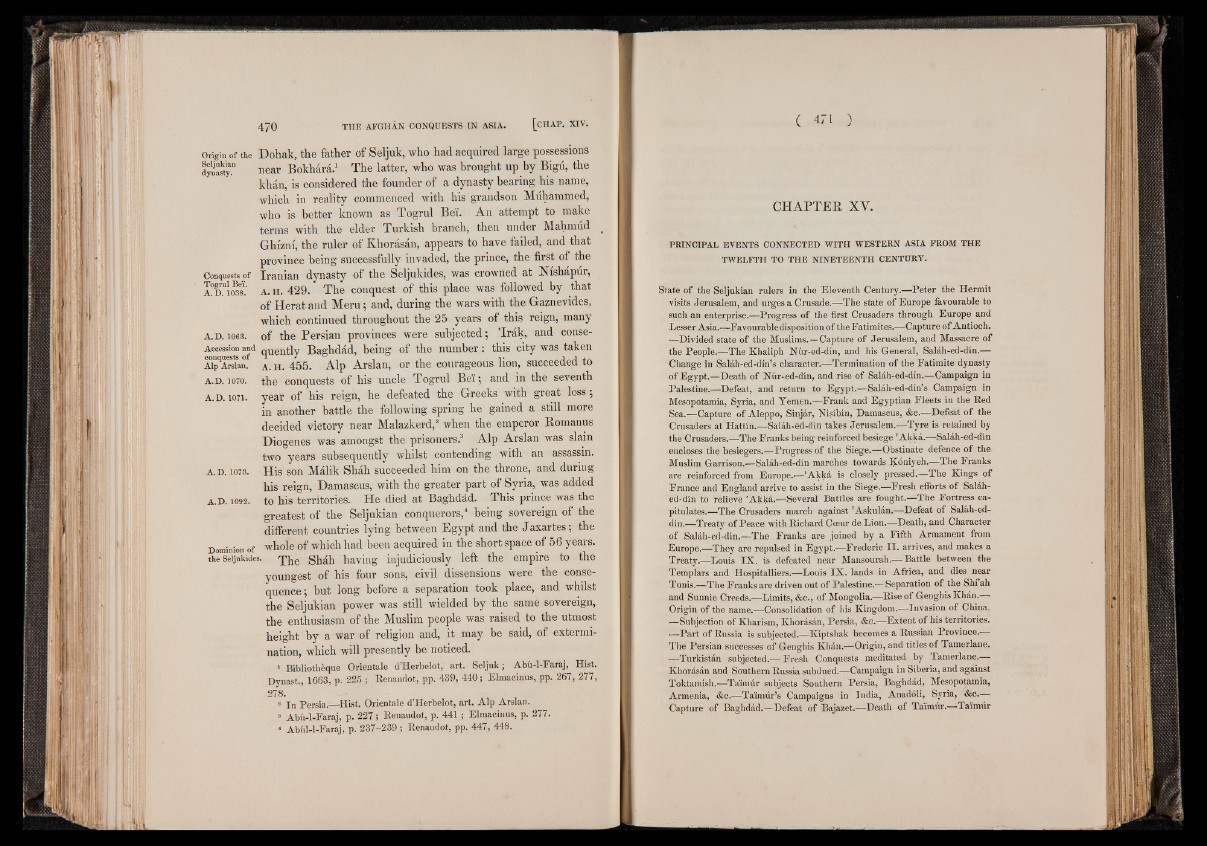
Origin of the Dohak, the father of Seljuk, who had acquired large possessions
dynasty*.11 near Bokhara.1 The latter, who was brought up by Bigu, the
khan, is considered the founder of a dynasty bearing his name,
which in reality commenced with his grandson Muhammed,
who is better known as Togrul Beï. An attempt to make
terms with the elder Turkish branch, then under Mahmud
Ghizni, the ruler of Khorâsân, appears to have failed, and that
province being successfully invaded, the prince, the first of the
Conquests of Iranian dynasty of the Seljukides, was crowned at Nishapur,
a ?d .“1m 8.‘ a . h . 429. The conquest of this place was followed by that
of Herat and Meru ; and, during the wars with the Gaznevides,
which continued throughout the 25 years of this reign, many
A .d . 1063. of the Persian provinces were subjected; ’Irak, and conse-
Accession and quently Baghdad, being of the number : this city was taken
A lp T i ia n . A. H. 455. Alp Arslan, or the courageous lion, succeeded to
A.D. 1070. the conquests of his uncle Togrul Beï; and in the seventh
a . d . io7i. year of his reign, he defeated the Greeks with great loss;
in another battle the following spring he gained a still more
decided victory near Malazkerd,2 when the emperor Boinanus
Diogenes was amongst the prisoners.3 Alp Arslan was slain
two years subsequently whilst contending with an assassin.
A .D . 10 7 3 . His son Malik Shah succeeded him on the throne, and during
his reign, Damascus, with the greater part of Syria, was added
a . d . 10 9 2 . to his territories. He died at Baghdad. This prince was the
greatest of the Seljukian conquerors,4 being sovereign of the
different countries lying between Egypt and the Jaxartes ; the
Dominion of whole of which had been acquired in the short space of 56 years,
the Seljukides. The Shah having injudiciously left the empire to the
youngest of his four sons, civil dissensions were the consequence;
but long before a separation took place, and whilst
the Seljukian power was still wielded by the same sovereign,
the enthusiasm of the Muslim people was raised to the utmost
height by a war of religion and, it may be said, of extermination,
which will presently be noticed.
1 Bibliothèque Orientale d’Herbelot, art. Seljuk; Abü-1-Faraj, Hist.
Dynast., 1663, p. 225 ; Renaudot, pp. 439, 440; Elmacin'us, pp. 267, 277,
278.
s In Persia.;—Hist. Orientale d’Herbelot, art. Alp Arslan.
3 Abii-l-Faraj, p. 227 ; Renaudot, p. 441 ; Elmaciuus, p. 277.
1 Abul-l-Faraj, p. 237-239 ; Renaudot, pp. 447, 448.
CHAPTER XV.
PRINCIPAL EVENTS CONNECTED WITH WESTERN ASIA FROM THE
TWELFTH TO THE NINETEENTH CENTURY.
State of the Seljukian rulers in the Eleventh Century.—P e ter the Hermit
visits Jerusalem, and urges a Crusade.—The state of Europe favourable to
such an enterprise.—Progress of the first Crusaders through Europe and
Lesser Asia.—Favourabledisposition of the Fatimites.—Capture o f Antioch.
—Divided state of the Muslims. — Capture of Jerusalem, and Massacre of
the People.—The Khaliph Nur-ed-din, and his General, Salâh-ed-din.—
Change in Salâh-ed-din’s character.-—Termination of the Fatimite dynasty
of Egypt.—Death o f Nur-ed-din, and rise of Salâh-ed-din.—Campaign in
Palestine.—Defeat, and return to Egypt,—Salah-ed-din’s Campaign in
Mesopotamia, Syria, and Yemen.—Frank and Egyptian Fleets in the Red
Sea.—Capture of Aleppo, Sinjâr, Nisibin, Damascus, &c.-—Defeat of the
Crusaders at Hattin.—Salâh-ed-din takes Jerusalem.—Tyre is retained by
the Crusaders.—The Franks being reinforced besiege ’Akkâ.—Salâh-ed-din
encloses the besiegers.^Progress of the Siege.—Obstinate defence of the
Muslim Garrison.—Salâh-ed-din marches towards Koniyeh.—-The Franks
are reinforced from Europe.—’Akkâ is closely pressed.—The Kings of
France and England arrive to assist in the Siege.—Fresh efforts of Salah-
ed-din to relieve ’Akkâ.—Several Battles are fought.—The Fortress capitulates.—
The Crusaders march against ’Askulân.—Defeat of Salah-ed-
din.—Treaty of Peace with Richard Coeur de Lion.—Death, and Character
of Salâh-ed-din.—The Franks are joined by a Fifth Armament from
Europe.—They are repulsed in Egypt.—Frederic I I . arrives, and makes a
Treaty.—Louis IX . is defeated near Mansourah.— Battle between the
Templars and Hospitalliers.—Louis IX . lands in Africa, and dies near
Tunis.—The Franks are driven out of Palestine.— Separation of the Shi ah
and Sunnie Creeds.—Limits, &c., of Mongolia.—Rise of Genghis Khan.—
Origin of the name.—Consolidation o f his Kingdom.-—Invasion of China.
'"^--Subjection of Kharism, Khorâsân, Persia, &c.—Extent o f his territories.
—P a rt of Russia is subjected.-—Kiptshak becomes a Russian Province.
The Persian successes of Genghis Khân.—Origin, and titles of Tamerlane.
—Turkistân subjected.— F resh Conquests meditated by Tamerlane.—
Khorâsân and Southern Russia subdued.—Campaign in Siberia, and against
Toktamish.—Taïmtir subjects Southern Persia, Baghdâd, Mesopotamia,
Armenia, &c.-—-Taïmtir’s Campaigns in India, Anadôli, Syria, &c.—
Capture of Baghdâd.—Defeat of Bajazet.—Death of Taïmur.—Taïmur